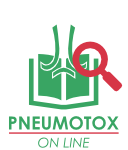The Drug-Induced Respiratory Disease Website
Philippe Camus, M.D.
Dijon, France
1
Drug and radiation history
2
Drug singularity - Correct identification of the drug
3
Consistent timing of exposure v. onset of symptoms
4
Clinical, imaging, BAL, pathological pattern consistent with the specific drug
5
Careful exlusion of another cause
6
Remission of symptoms with removal of drug
7
Recurrence with rechallenge (rarely advisable)
8
Causality assessment
See also under

